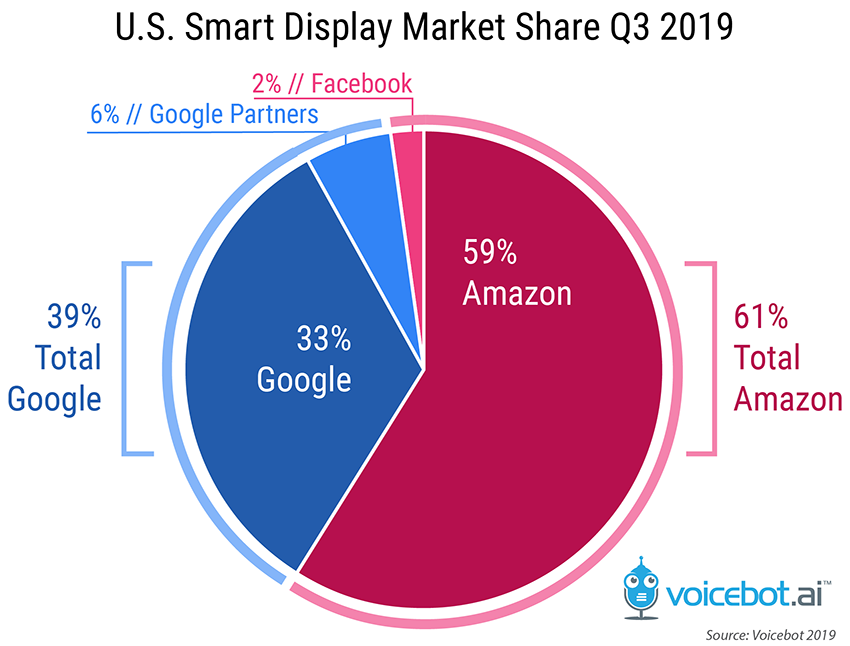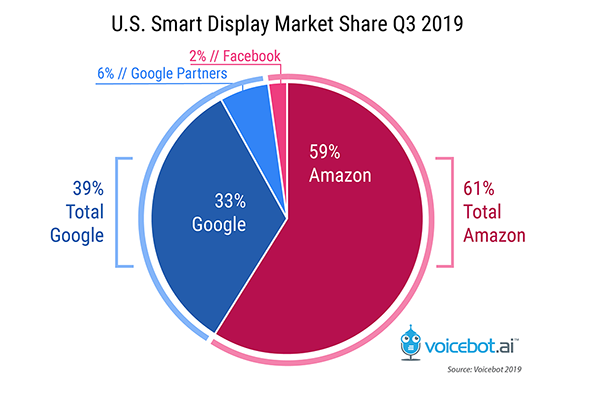Amazon Continues to Lead in Smart Displays with 59% Share While Facebook Portal Only Tallies 2% Adoption Among Smart Speaker Users
Amazon Echo Show and Spot, both introduced in 2017, were the first smart displays. These devices integrate voice assistant based user interfaces with display screens to augment conversational interaction with images and video. At the end of 2018, Amazon’s first-mover advantage was evident in its 67% device market share in the U.S. All of the smart displays to date have adopted either Alexa or Google Assistant as a voice interface and that includes Facebook’s Portal which uses Alexa.
Google Assistant based smart displays began arriving in the U.S. from third parties such as Lenovo, JBL, and LG in the late summer and autumn of 2018 and then from Google directly in October. Around the same time, Facebook launched its Portal smart display with Alexa. As a result, at the end of Q3 2019, Google Assistant based voice assistants and Facebook Portal had been available for a full year while Amazon’s offerings were celebrating two years in the market.
The additional time in the market has clearly helped the Google Assistant smart display ecosystem erode some of Amazon’s market share which fell from 67% to 61% when including Facebook Portal as an Alexa-enabled device. During that time, Google Assistant enabled smart displays rose to 39% with 33% from Google manufactured devices and 6% from Google partners. This is positive momentum for the Google Assistant ecosystem, but the three-fifths market share for Amazon means that Alexa remains dominant for this device category in the U.S.

Smart Display Ownership Rose by About 1 Million in First 9 Months of 2019
At the end of 2018, there were about 8.7 million smart display owners in the U.S. and over the past nine months that has risen to 9.6 million. Amazon leads with about 6 million smart display users while Facebook has a little over 200,000 users and third-party Google Assistant devices over 650,000. Google smart displays are owned by about 3.6 million U.S. adults. Granted, some of the users own multiple smart displays and others own multiple smart displays from multiple manufacturers. These figures don’t represent unit sales but rather the installed base of users.
In all, about 3.8% of U.S. adults have access to a smart display and that reflects just under 13% of all smart speaker owners. This is actually a slight fall in percent of smart speaker owners with a smart display from January 2019 which indicates that the overall expansion of smart speakers is rising at a faster rate than smart displays. This may change in Q4 when higher-priced devices get more consumer attention for gift giving.
Whether or not smart display adoption continues to grow is an open question. There is still very little content optimized for smart display experiences. The device makers tend to emphasize use cases for cooking in the kitchen, smart home control, and video chat. The latter is the most obvious benefit of smart displays that is truly device optimized. Growth of smart display adoption will require a stronger rationale about how they are superior to the experiences offered by the less expensive smart speakers. That means either the video chat use case needs to become more popular or new content and experiences will need to be developed for the devices. It is not clear either of these will arrive in time for the Q4 holiday season.
Follow @bretkinsella Follow @voicebotai
Echo Show 5 Heats Up the Battle for the Nightstand. Will the New Smart Display Replace Echo Spot?









